So much heritage and history in a Jaro fiesta
There are places that live best in one’s memory, better than anywhere else in the real world. Jaro is one of those places.
The fiesta de Jaro occupies an even more special spot worthy of remembrance. It commemorates the miraculous Nuestra Señora de la Candelaria (Our Lady of the Candles), which was first discovered by fishermen floating in the river of Jaro in the 16th century. The limestone statue at first seemed too heavy to haul out of the waters until it was piously declared (by the Bishop) that it would be delivered to the church.
Legend has it that the Virgin suddenly became buoyant, as though it longed to be taken to holy premises.
A cathedral was built in short order and the statue is said to have grown intriguingly over the years, so much so that it became too big for its first setting above the altar and is now ensconced on the cathedral’s balcony, thus making plain its desire never to be confined and to be seen by as many of the faithful as possible.
As part of the festivities, a Queen of the Jaro Fiesta is selected and crowned to honor Our Lady. In 1961, that honor went to Ma. Therese “Mariter” Lacson Jalandoni, a society swan who is de buena familia on both sides of the family. (Her mother, Teresa Ledesma Lacson, is from old Talisay and is related to the late mayor of Manila, Arsenio Lacson.)
The Jalandoni name is woven into the very history of IloIlo, thanks to an auspicious start in sugar.
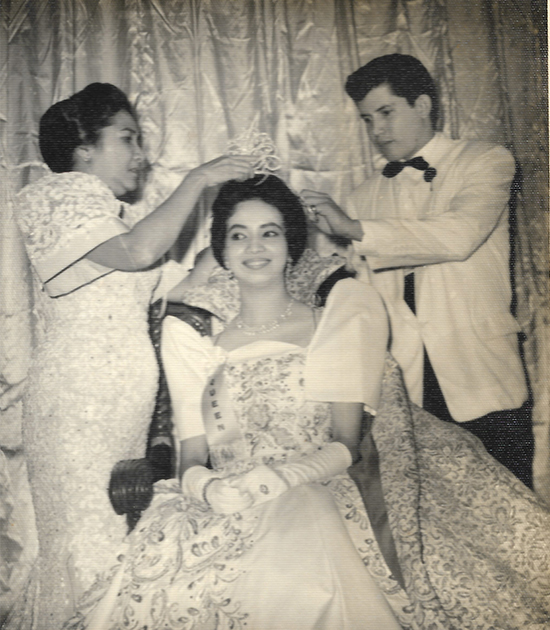
At one time, the pater familias Santiago had built an impressive mansion on Plaza Real right beside the cathedral. (It now belongs to the Arzobispado.) Not surprisingly, the committee handpicked Mariter but there was one little obstacle that now seems so quaint amid our current obsession with pageants: students from Catholic convent-schools needed special dispensation to participate.
Mariter remembers calling on then-Archbishop Rufino Santos, accompanied by a delegation led by her father Hector Montinola Jalandoni, to seek his permission. She exclaimed, “It wasn’t like a beauty contest with swimsuits. It’s more similar to the original Manila Carnival when the likes of Maria Kalaw-Katigbak was chosen to be Queen.”
In fact, a beauteous ancestor of Mariter — Marietta Jalandoi-Rotea — was one of the first Queens of Jaro. (Mariter has been told often that she bears a strong resemblance to her.) Her reign would set a precedent of sorts, opening the door for other colegialas to be named Queen.
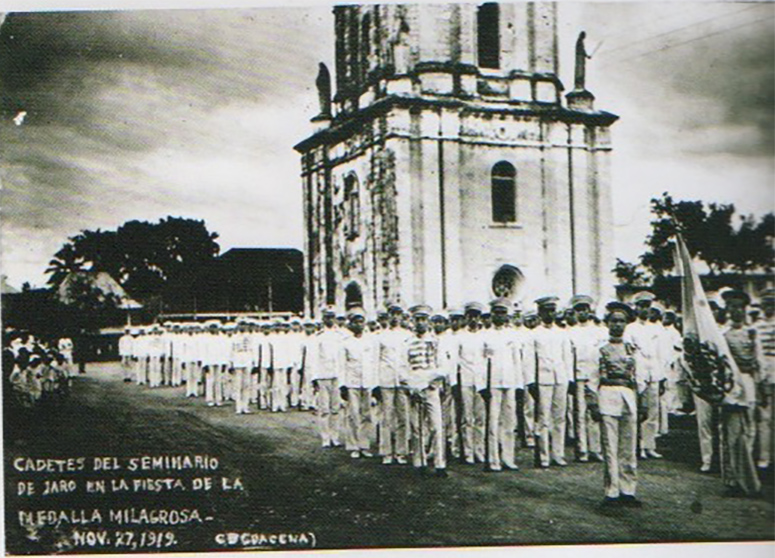
One interesting sidebar to these fascinating memories is the name Bert Hernandez, a talented designer from the 1960s whose name has been lost in the mists of fashion time, but who nevertheless deserves recognition for his dramatic confections.
Mariter recalls that Bert Hernandez was “very low-key” but was considered a contender in the circle of Ramon Valera. He would be one of her go-to couturiers and she would become one of his favorite models when he presented fashion shows at Malacañang Palace. (Mariter would eventually become Mrs. Arthur Macapagal on Dec. 22, 1965.)
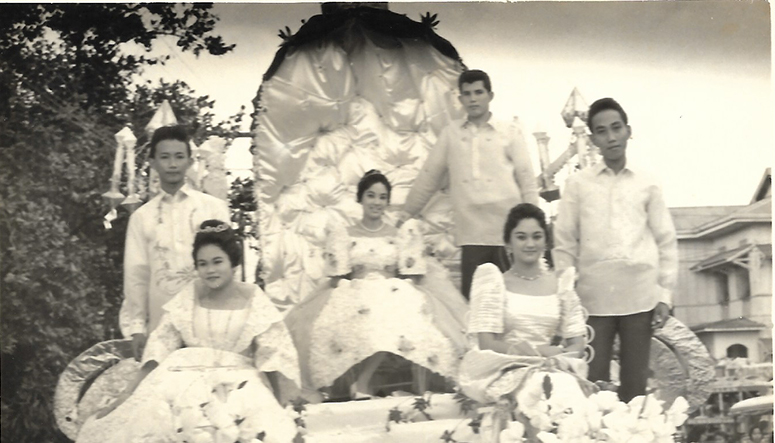
The Jaro Fiesta, incidentally, occurs on three days dotted over two months, making it necessary to have a trio of different ensembles for each occasion. The first one takes place in the last week of January and is known as the “Inaugural Parade,” which involves the Queen and her court appearing on a float that travels the streets of Jaro to declare the opening of the fiesta.
Mariter’s court included two princesses, Marimar Barrios-Pratt and Mary Millicent Villalon (with their escorts, Leopoldo Locsin and Ernesto Mirasol). Her own consort was the dashing Vincent “Ting Tong” Aldeguer.
A local couturier named Ben Natividad of Iloilo pinch-hit for that first occasion. He created a cocktail-length, swallow-tail terno in dove white accented with vivid aqua and fuchsia petals to Mariter’s specifications. (“I wanted the Filipino terno design for all of the gowns,” she emphasizes.)
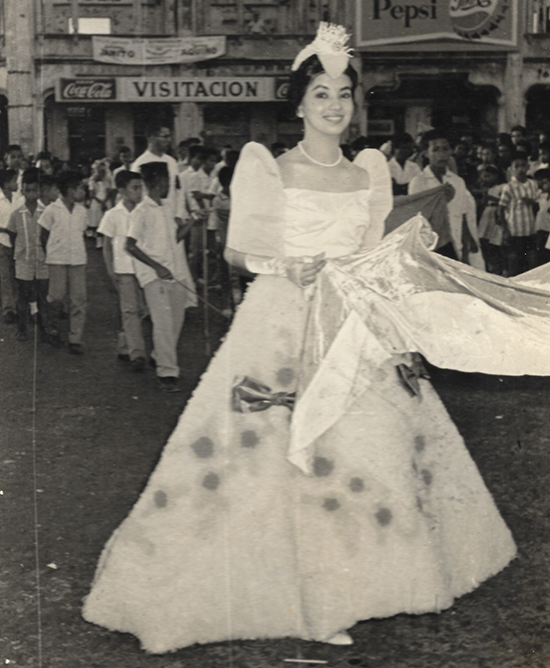
Bert Hernandez stepped in for the heavy-hitting festivities for the day of the actual Jaro Fiesta on February 2. He designed a full-length terno, this time sprinkled with orange floral appliqués.
Mariter was described by society columnist Virginia Benitez Licuanan in the Manila press thus: “A very pretty and poised young lady wearing a gown of thousands of yards of yellow ruched tulle, Mariter exemplifies what we have said about Iloilo women being as elegant as any Manila beauty. As a matter of fact, quite a number of the so-called Manila beauties are actually Ilonggas.”
This second event featured a long procession led by the chosen Queen of that year.
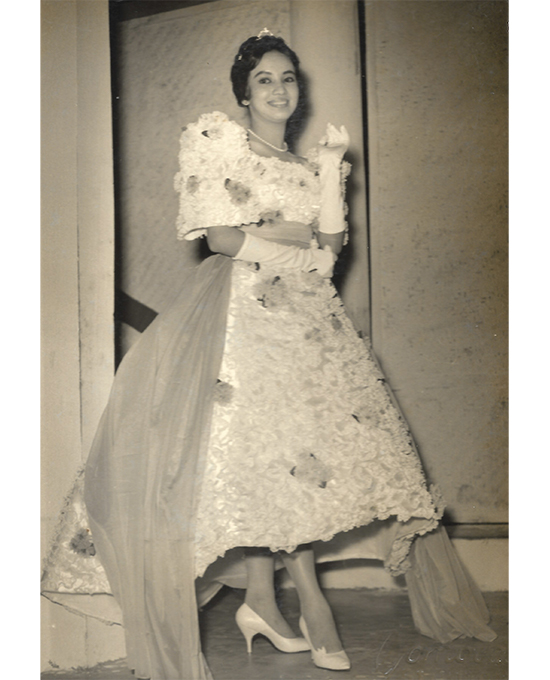
Finally, there was coronation night, which in 1961 was presided over by no less than the First Lady Leonila Garcia, whose presence attracted as many people as a movie star’s.
“Crowds lined the sidewalks to get a glimpse of the First Lady on her first Iloilo visit this year,” Licuanan cooed. This time, Hernandez pulled out all the stops and designed a majestic hoop-skirted ivory gown. It featured a graceful scalloped skirt covered in ornate gold embroidery truly fit for royalty. (The gown itself was executed by Gloria Magalona working out of an Iloilo atelier.)
It was a glorious start to a historic decade in the Philippines.
What did Mariter Jalandoni Macapagal remember most? “The atmosphere, the camaraderie, we would visit each other’s houses, have luncheons with family, and of course, the whirl of parties,” she reminisces. But, says Mariter, there can only ever be one Queen — “That would be Iloilo, truly the queen city of the South.”



